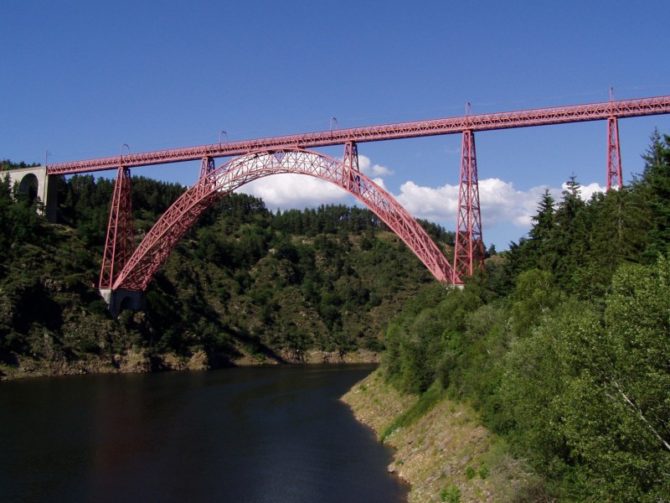Eiffel’s Other Masterpieces

Because his name is inextricably linked to that too-famous symbol of Paris, Gustave Eiffel rarely gets credit for the many other feats of civil engineering that made him one of the greatest innovators of his time. Yet more than just a one-tower genius, the master of metal architecture was really a man of many bridges.
Try this experiment: Ask people you know, “Who designed the Eiffel tower?” Most, probably all, will reply, “Monsieur Gustave Eiffel, of course. The illustrious engineer and brilliant entrepreneur whose portrait by Nadar is almost as famous in France as his tiny office, reconstituted in its dizzying aerie above Paris.” Then, assuming your most nonchalant air, let it be known to these ill-informed folks that the tower was actually conceived and designed by Maurice Koechlin and Emile Nouguier, with the last-ditch help of architect Stephen Sauvestre. You might add that it took strenuous effort on the part of the two engineers, who were employed in M. Eiffel’s research office, to convince their boss of the project’s merit.
Once persuaded, obviously, Eiffel appropriated the idea and poured all his energies into its implementation. And, for his pains, reaped all the benefits. He used his inventiveness, motivational skills and the maniacal sense of organization for which he was famous to ensure that the pharaonic effort to build la tour Eiffel would proceed without incident. The construction work resulted in a single fatality. “One too many,” he judged.
The project was scarcely his maiden effort. Eiffel’s single-minded determination and path-breaking ingenuity were in peak form well before the run-up to the Universal Exposition of 1889. By then, the Eiffel workshop in Levallois had been in existence for nearly a quarter of a century, rigging and riveting improbable Erector set inventions destined to span rivers in France, Europe and around the world. At age 25, after attending the Ecole Centrale des Arts et Manufactures in Paris, young Eiffel had taken a job-fallen into it, really-with one Charles Nepveu, “manufacturer of steam-powered machinery, tools, forges, boilers, sheet metal, and stationary and rolling stock for railroads.” It was in the employ of this one-man band that he executed the incredible railway bridge across the Garonne, a mostly metal span to carry trains across the river to Bordeaux’s Gare St-Jean. The property of France-Rail, Eiffel’s creation fell into disrepair, and its functions were taken over by a new TGV Atlantique bridge. The aging structure was slated for demolition until Myriam Arnaudie-Eiffel, the builder’s great-granddaughter, arranged for its rescue and refurbishment as a landscaped pedestrian walkway above the river.
By 1866 Monsieur Eiffel had become a specialist in metal architecture, especially bridges over the widest, most inaccessible, most steeply embanked waterways-the more challenging, the better. He would go on to build these “works of art” across the Sioule, Nive and Thouet rivers in France, export them to Portugal (the 1877 Maria Pia viaduct on the Douro, the longest span in Europe) and even Peru. His output during this period included the tours de force that established for the maison Eiffel a worldwide reputation, notably the prodigious single-arch Garabit viaduct, the highest in the world at the time of its construction.
Early on, Eiffel saw that these metallic creations would be more economical and easier to build than their equivalents in stone and brick. His creative mind spun out one innovation after another: Cantilever construction and the use of compressed air were two of the most prominent. The elegant lines of these works-a stunning synthesis of power and lightness, both aesthetically and technically-soon became the master’s signature.
His trajectory had been launched. From then on, Eiffel would be commissioned to design ever more prestigious structures-works produced more for image and cachet than functionality. First it was the gigantic “vestibule” to the 1878 Universal Exposition on the Champ de Mars. A few years later, in a collaboration that was the focus of much publicity-the term médiatisation had not yet been coined-Eiffel joined forces with Alsatian sculptor Frédéric Auguste Bartholdi to build the armature of the Statue of Liberty. Yes, Miss Liberty’s skeleton marched straight out of Eiffel’s workshop.
How could the “thousand-foot tower,” an old concept reimagined to celebrate the French Revolution’s hundredth anniversary, this sumptuous, almost mad undertaking, fail to arouse his ambition? If it is true that Nouguier and Koechlin had to pull out all the stops to “bring the boss around,” in the end this metallic masterpiece would embody far more than its creators’ genius: the impetus of an era toward science, and its reigning faith-astonishing, in retrospect-in progress.
And that is the role of a great man: to offer their contemporaries dreams of towering size.
Share to: Facebook Twitter LinkedIn Email



